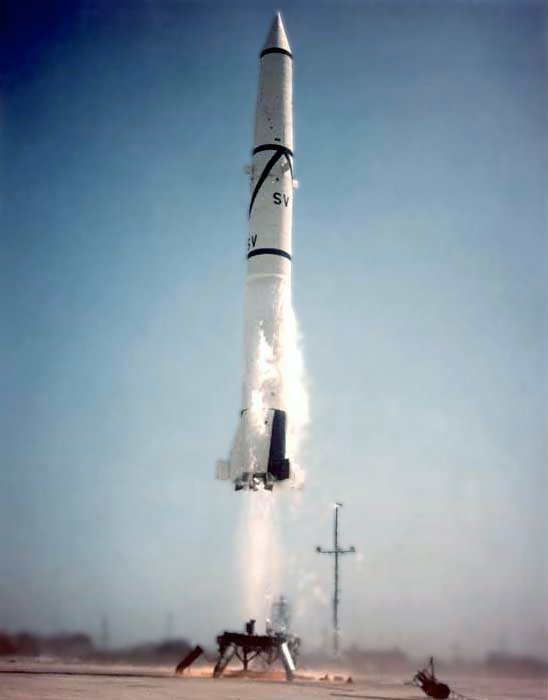Redstone

Redstone launch from Cape Canaveral.
Redstone was the first operational American ballistic missile and a rocket that played a key role in America's nascent space program. It was originally a product of the U.S. Army Ordnance Guided Missile Center (OGMC) at the Redstone Arsenal in Huntsville, Alabama. The outbreak of the Korean War in 1950 coupled with a growing concern over Soviet ballistic missile advances encouraged the development of a more advanced version of the German V-2. Since nuclear weapons were still relatively heavy at the time, the Redstone missile was designed to carry a 1,800-kg warhead a distance of 800 kilometers, a range later reduced to 320 km so that development could be speeded up by using existing Navaho engine technology.
In 1950, Wernher von Braun and his team of German scientists were reassigned to OGMC from their previous bases at Fort Bliss, Texas and White Sands, New Mexico. Thus von Braun was able not only to help develop a viable American weapons program but also fulfill his dream of designing rockets that would carry satellites and men into space. The Redstone proved instrumental in both efforts. Initially it was built as a field-mobile missile capable of being launched by combat troops. The Redstone engine, based on that of the Navaho and developed by North American Aviation, burned a combination of liquid oxygen (LOX) and a liquid fuel consisting of 75% ethyl alcohol and 25% water. Its trajectory was controlled by vanes attached to four fixed fins at the base of the missile which were moved to deflect the engine's exhaust – a steering method nearly identical to that of the V-2. Before launch, the Redstone was supported on a circular stand fitted with a cone-shaped flame deflector to help keep the missile stable when its engine was fired. Following launch, it was controlled by an inertial guidance system based on air-breathing gyroscopes. The reentry vehicle, which could carry a nuclear weapon, separated from the missile after engine cutoff.
Following its first launch from Cape Canaveral in August 1953, the Redstone made numerous test flights until it was declared operational in June 1958. The Army Ballistic Missile Agency (ABMA) granted a Redstone production contract to Chrysler, and over 1,000 missiles were delivered. The Redstone was deployed by Field Artillery Missile Groups (FAMG) in West Germany. Comprised of about 600 people and many large vehicles, each FAMG had to operate a processing plant that could yield 20 tons of LOX per day. ABMA development and testing of the Pershing missile began at about the same time the Redstone was declared operational. Work on the Pershing progressed quickly, and it replaced all Redstones in the field by 1963. Although it had an operational life of only five years, the Redstone remains one of the most important vehicles in the history of the American space program. It was used as a first stage booster for the Jupiter C, later renamed Juno I, which carried the first American satellite, Explorer 1. A modified Redstone missile, mated to a Mercury capsule, and known as the Mercury-Redstone, successfully carried Alan Shepard, the first American astronaut, into space on 5 May 1961. Although the Redstone was only powerful enough to support suborbital manned flights, the vehicle did repeat its historic task as Virgil Grissom flew aboard a Mercury Redstone on 21 July 1961.
As a follow-up to the Redstone program, the ABMA continued development of the Juno family of space launch vehicles. With the Redstone as the basis of the first generation Juno 1, additional versions were designed. The final generation, called Juno 5, was to employ a first stage array of eight Redstone missile stages clustered around one central Jupiter missile stage. Although the Juno rocket family was renamed Saturn, the Saturn I bore great resemblance to the proposed Juno V. In essence, the Saturn rockets, which were instrumental in the effort to carry the first men to the Moon, were direct descendants of the Redstones that had figured so prominently in getting America's space program off the ground.
| Specifications | |
|---|---|
| length | 21 m (69 ft) |
| diameter | 1.8 m (5.8 ft) |
| mass (at launch) | 27,700 kg (61,000 lb) |
| range | 320 km (200 miles) |
| thrust | 230,000 newtons |


